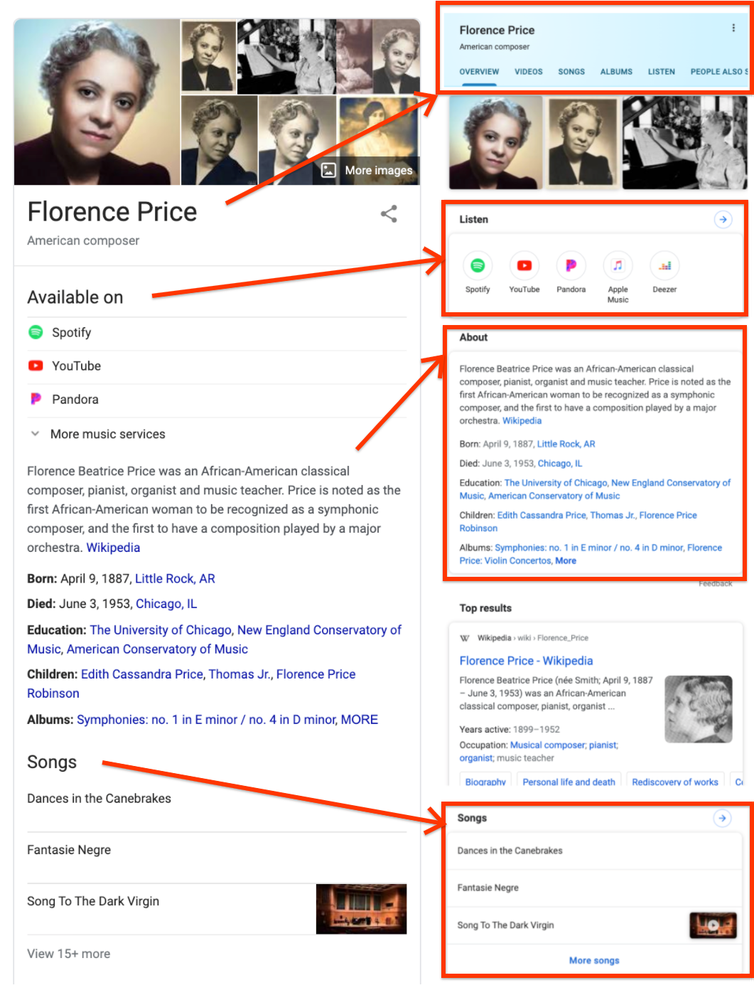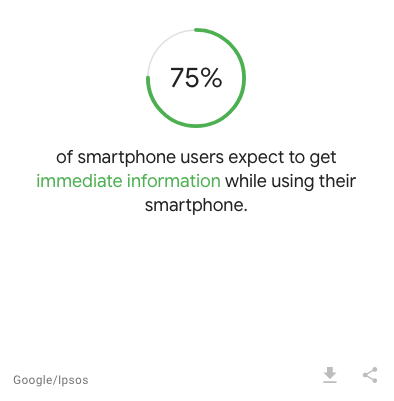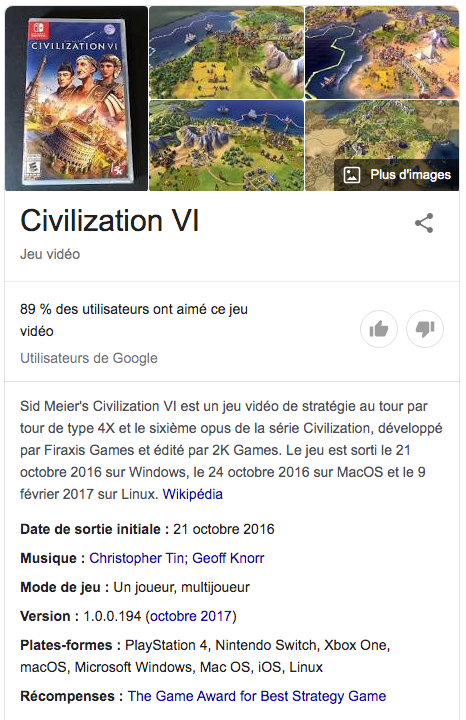Content experts, the Knowledge Graph is full of rewards for you!
Google and the Knowledge Panel
Google owns most of the online content discovery. In most countries Google’s properties represent more than 70% of the search landscape. To make search easier Google has diversified the type of content that they display and the knowledge panel is one of these new search results formats – see Heat Map below.
As we can see from this study, content diversification has a huge impact on how people interact with search results. As a content producer, you want your content (article, infographics, video, etc.) to generate some level of engagement. User engagement can be a direct sale, a review, a comment, a share, a subscription, etc., which means Google’s Knowledge Graph (on which the knowledge panel is based) is a great tool to attract people who are interested in your product/service.

In a recent post, Danny Sullivan wrote a reintroduction to the Knowledge Graph. And here is how he describes the knowledge panel:
Special boxes with information about people, places and things. We call these knowledge panels. They’re designed to help you quickly understand more about a particular subject by surfacing key facts and to make it easier to explore a topic in more depth. Information within knowledge panels comes from our Knowledge Graph, which is like a giant virtual encyclopedia of facts.
We can highlight a few key elements from this description:
- Information
- Facts
- Topics
It is therefore not surprising to see the knowledge panel appear when you search for a specific content which involves a person, an organization or a thing with facts. Google is usually able to extract these information directly from the Knowledge Graph.
What is the Knowledge Graph?
“The Knowledge Graph is a knowledge base used by Google and its services to enhance its search engine’s results with information gathered from a variety of sources” (read more on Wikipedia). It is a huge database with more than 18 billion facts allowing Google to directly answer more than 30% of all the queries recorded in its system. Let’s just conclude that, as a content expert, you should be aware Google is already able to answer most of the questions your content is addressing, provided it features key facts.
The knowledge panel is displayed for a lot of queries, starting by queries related to places, companies, people, animals, events, etc. Of course, this can be seen as a threat in the sense that your content is not likely to get a click (only an impression instead) as Rand Fishkin pointed out in several of his public statements. On the other hand, as Cindy Crum sometimes mentions, having your content displayed on all these new formats is definitely an opportunity and you should improve the way you measure it. Mobile Moxie is a great tool for that.
I personally see it as an opportunity to earn some visibility, notably because Google uses various sources to display several boxes, especially on mobile as pointed out in Danny Sullivan’s article.

Any business has the ability to rank on Google’s first page via the knowledge panel. Wikipedia is not the only data source for the Knowledge Graph. But anyone can also claim a link from Google if other businesses don’t do so (it’s pretty much similar for unclaimed businesses on Google My Business).
Many knowledge panels can be “claimed” by the subject they are about, such as a person or a company. The claiming process—what we call getting verified—allows subjects to provide feedback directly to us about potential changes or to suggest things like a preferred photo.
How could you benefit from the knowledge Graph?
Basically you want your content to be found online. Since 75% of users search on Google to find direct answers, if you are not displayed on Google’s SERPs (Search Engine Results Pages), nobody will ever hear about you.

Thus you should try to rank not only the full article but also a part of it: an image, a video, a map, a date (if it is event-related). I believe content diversification and length are elements you should consider while writing a piece of content. In fact, Google is able to extract several informations from your web page to directly display them on the knowledge panel. These structured data are listed here: https://developers.google.com/search/docs/data-types/article

How the Knowledge Graph will impact your copywriting
If your content is well tagged using structured data, Google may directly display it on one of their knowledge panels. This is good but you want more. You want clicks to get more traffic and more leads. That is why you should focus on the philosophy behind he Knowledge Graph and follow the 3 recommendations below.
1. Understand the structure of the Knowledge Panel
Consider structuring your article this way (as mentioned in the Google’s publication above)
- Title and short summary of the topic
- A longer description of the subject
- A picture or pictures of the person, place or thing
- Key facts, such as when a notable figure was born or where something is located
- Links to social profiles and official websites

2. Topics matter more than keywords
You should start your brainstorm by looking at topics and entities rather than keywords and their search volumes. Most of the content strategists start brainstorming on keywords tools. The reality is that if you are trying to rank well for “swimming pool” and you start your brainstorm on – for instance – Answer the public you will have the following good suggestions:

This is probably a good start for some people, but if you do so you are only going to get keywords related to “swimming pool” in your content. Depending on the intent you are trying to cover (navigational, transactional, etc.) it might be OK to start that way. But let’s say we really don’t know what is the final intent of our audience and let’s assume you sell swimming pool equipment. If you start your brainstorming process at the topic level you are going to end up with better ideas:
- Backyard: pools design, landscaping
- Olympic size
- Summer waves
- Equipment: sand filter, filter pump, metal frame
- Heater: solar, heat pump, electric heater
Combining these two methods (topics then queries) will not only allow you to get more ideas and thus to better cover the subject, but also to address users’ needs more specifically. Using this methodology, I would suggest to structure an article on “swimming pools” this way:
- Introduction with the main component of a swimming pool
- How to design a swimming pool for your backyard
- How to enjoy your swimming pool with summer waves
- Top equipment to maintain your swimming pool this summer
- Etc.
3. Use entities in your copy to enrich your content
The Knowledge Graph is a system that understands facts and information about entities from materials shared across the web. But what is an entity?
According to Google, an entity “represents a phrase in the text that is a known entity, such as a person, an organization, or location”. To better understand the use of entities in search please watch this video from Moz.
Entities are not useful for SEO only, they are above all crucial for content producers. The design of a school database for instance will include students, teachers, courses, etc. as entities. Those entities will then have attributes such as the student ID, name, date of birth, etc.
If you write a piece of content with entities in mind, you are not only going to describe you product or service but also write about the topic as a whole by using arguments that reinforce the link between your offer and the topic. As seen above, if you are a retailer selling swimming pools, it is not enough to describe your products features but instead address the various ways people could enjoy a swimming pool during Summer, the position in the house (backyard design), the required equipment, how to deal with swimming pool water…
Conclusion
We have recommended content strategists to consider the Knowledge Graph. Google is the main online traffic provider and when they change the way people access to your content, you should either adapt or invest on other traffic drivers (influencers, social media, events…).
However SEO is usually the cheapest solution to acquire visitors on your web properties. Therefore, you might want to follow these instructions regarding content creation:
- Start your brainstorm process at the topic level
- Use the same content structure than the Knowledge Graph when possible
- Learn more about entities and add them to your content workflow
